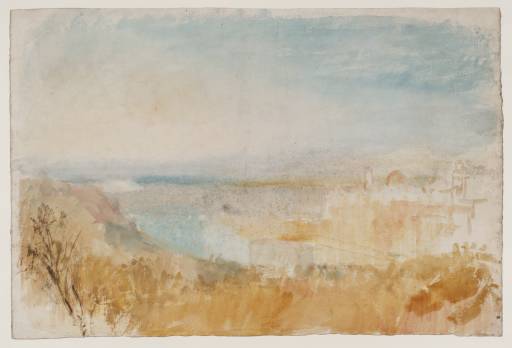Joseph Mallord William Turner Florence c.1827
Joseph Mallord William Turner,
Florence
c.1827
Joseph Mallord William Turner 1775–1851
Florence c.1827
D25138
Turner Bequest CCLXIII 16
Turner Bequest CCLXIII 16
Watercolour on white wove paper, 328 x 486 mm
Watermark ‘J Whatman | Turkey Mills | 1819’
Blind-stamped with Turner Bequest monogram bottom centre
Stamped in black ‘CCLXIII – 16’ bottom right
Watermark ‘J Whatman | Turkey Mills | 1819’
Blind-stamped with Turner Bequest monogram bottom centre
Stamped in black ‘CCLXIII – 16’ bottom right
Accepted by the nation as part of the Turner Bequest 1856
Exhibition history
1966
Turner Watercolours, Arts Centre, Folkestone, January–February 1966 (no catalogue).
1983
Turner Abroad: Watercolours from the Turner Bequest Loaned by the British Museum, Tate Gallery, London, June–December 1983 (no catalogue).
1991
Turner: The Fourth Decade: Watercolours 1820–1830, Tate Gallery, London, January–May 1991 (78, as ‘Florence from San Miniato: preparatory study’, c.1827, reproduced).
References
1820
A.J. Finberg, A Complete Inventory of the Drawings of the Turner Bequest, London 1909, vol.II, p.815, CCLXIII 16, as ‘River, with town. Possibly Italian’, c.1820–30.
1828
Andrew Wilton, Turner Abroad: France; Italy; Germany; Switzerland, London 1982, p.46 no.40, as ‘Florence: colour study’, c.1828, pl.40 (colour).
1827
Ian Warrell, Turner: The Fourth Decade: Watercolours 1820–1830, exhibition catalogue, Tate Gallery, London 1991, p.66 no.78, as ‘Florence from San Miniato: preparatory study’, c.1827, reproduced.
1997
Eric Shanes, Turner’s Watercolour Explorations 1810–1842, exhibition catalogue, Tate Gallery, London 1997, pp.29, 98 Appendix I ‘Italy’, 99 Appendix I ‘Literary and Book Illustrations’.
This ‘colour beginning’ was recognised by Andrew Wilton1 as showing a view over Florence, looking north-west across the River Arno to the city with the Duomo in the distance on the right. Turner unusually produced two similar but distinct variant watercolours in about 1827 (Herbert Art Gallery & Museum, Coventry)2 and the following year (British Museum, London).3 Another version is long untraced, and its status as an autograph work is uncertain,4 as is that of a fourth, in a private collection.5 Of the Coventry and British Museum works, the former, with its figures to the right of central trees in the foreground, was the source for the engraving Florence in the 1828 edition of the annual Keepsake (Tate impressions: T05105, T06138; see the Introduction to this section). The other variant is superficially similar, but shows a group to the left of the trees and differs in many other smaller ways.
Towards the end of 1819, Turner spent time in Florence on the return leg of his first Italian tour, making drawings of the city from this direction in the Rome and Florence sketchbook (Tate D16571–D16573, D16590–D16594, D16596; Turner Bequest CXCI 51–52, 62a-64a, 65a). Although all the watercolours have come to be known conventionally as Florence, from San Miniato,6 implying a viewpoint in the vicinity of the basilica of San Miniato al Monte, in her catalogue entries for the sketches Nicola Moorby has noted Cecilia Powell’s observations on Turner’s manipulation of the scene,7 and instead placed the vantage points of D16590 and D16594, relatable to the 1827–8 works, somewhat further north near the church of San Salvatore al Monte.
In fact, Turner was already familiar with the prospect before his 1819–20 tour, having made a watercolour of Florence from the Chiesa al Monte (private collection),8 engraved in 1820 for James Hakewill’s Picturesque Tour of Italy (Tate impressions: T06027, T05110, T06158); for the project in general, see Moorby’s Introduction to the ‘First Italian Tour 1819–20’ section of this catalogue. That view had been based on Hakewill’s own direct drawing, and although its foreground is radically different, the detailed background probably informed Turner’s later works,9 as his own sketches in the area were not very meticulous. The immediately striking difference in the 1827–8 watercolours is the introduction of what Wilton characterised as the ‘forceful central vertical’10 of a cypress tree with others descending over the brow of the hill to the right towards the river; they are not hinted at in the present work, but the ‘basic opposition of warm colours on the right – the salmon pinks and ochres of the city – to the cooler hues of the river on the left is essentially the same’.11 As is typical of such studies, there is no clear indication of any figures.
Along with many watercolours connected with the ongoing Picturesque Views in England and Wales (see the ‘England and Wales Colour Studies c.1825–39’ and ‘England and Wales c.1826–38’ sections), the Coventry version was among three Italian views exhibited by Charles Heath at London’s Egyptian Hall in the summer of 1829, apparently intended for a complementary Picturesque Views in Italy project due for publication in 1830, which came to nothing.12 As already noted, Florence had appeared in 1828’s Keepsake, and the two others followed in the 1829 edition. Turner revisited the scene when he returned to Italy in 1828, recording it in his Genoa and Florence sketchbook (Tate D21497, D21546, D21557–D21562; Turner Bequest CCXXXIII 44, 71, 77–79a).13
Ibid., p.384 no.726, as private collection; noted by Ian Warrell as ‘attributed’ (unpublished notes, 2002, Tate files).
Ibid., p.384 no.728, reproduced, as ‘replica’ of no.727; noted by Warrell as ‘attributed’ (unpublished notes, 2002, Tate files).
See Cecilia Powell, Turner in the South: Rome, Naples, Florence, New Haven and London 1987, pp.93–4.
Verso:
Blank; rubbed, with scattered abrasions. Inscribed in pencil ‘D.25138’ bottom right.
Matthew Imms
March 2017
How to cite
Matthew Imms, ‘Florence c.1827 by Joseph Mallord William Turner’, catalogue entry, March 2017, in David Blayney Brown (ed.), J.M.W. Turner: Sketchbooks, Drawings and Watercolours, Tate Research Publication, July 2017, https://www

